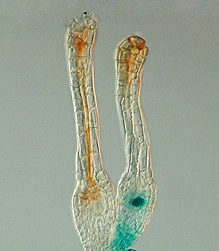Archegonium

Anarchegonium(pl.:archegonia), from theAncient Greekἀρχή( "beginning" ) andγόνος( "offspring" ), is a multicellular structure or organ of thegametophytephase of certainplants,producing and containing theovumor femalegamete.The corresponding male organ is called theantheridium.The archegonium has a long neck canal or venter and a swollen base. Archegonia are typically located on the surface of the plantthallus,although in thehornwortsthey are embedded.
Bryophytes[edit]
Inbryophytesand othercryptogams,spermreach the archegonium by swimming in water films, whereas inPinophytaandangiosperms,thepollenare delivered by wind or animal vectors and the sperm are delivered by means of apollen tube.[citation needed]

In themossPhyscomitrella patens,archegonia are not embedded but are located on top of the leafygametophore(s. Figure). ThePolycombprotein FIE is expressed in the unfertilizedegg cell(right) as the blue colour afterGUS stainingreveals. Soon afterfertilisation,theFIE geneis inactivated (the blue colour is no longer visible, left) in the young embryo.[1][2]
Gymnosperms[edit]
They are much-reduced and embedded in the megagametophytes ofgymnosperms.The term is not used forangiospermsor the gnetophytesGnetumandWelwitschiabecause the megagametophyte is reduced to just a few cells, one of which differentiates into the egg cell. The function of surrounding the gamete is assumed in large part bydiploidcells of themegasporangium(nucellus) inside theovule.Gymnospermshave their archegonium formed afterpollinationinside femaleconifer cones(megastrobili).[3]
References[edit]
- ^Assaf Mosquna, Aviva Katz, Eva L. Decker, Stefan A. Rensing,Ralf Reski,Nir Ohad (2009): Regulation of stem cell maintenance by the Polycomb protein FIE has been conserved during land plant evolution. Development 136, 2433-2444.[1]
- ^The Polycomb gene FIE is expressed (blue) in unfertilised egg cells of the moss Physcomitrella patens (right) and expression ceases after fertilisation in the developing diploid sporophyte (left). In situ GUS staining of two female sex organs (archegonia) of a transgenic plant expressing a translational fusion of FIE-uidA under control of the native FIE promoter. "Development -- About the Cover (July 2009, 136, (14))".Archived fromthe originalon 2009-06-26.Retrieved2009-07-03.
- ^"Brooklyn Botanic Garden".Archived fromthe originalon 2009-10-27.Retrieved2008-02-09.
